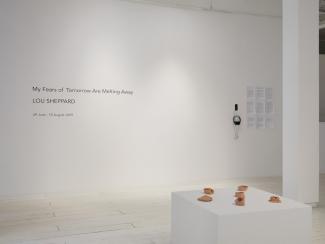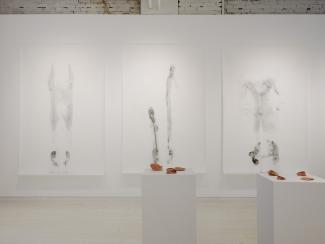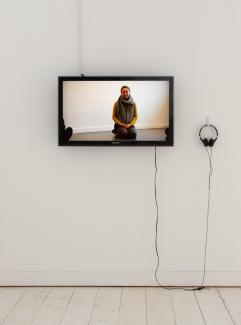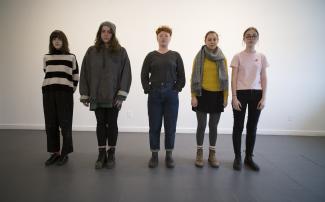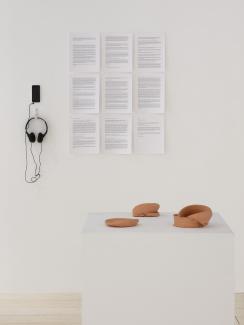This has been a conversation from the beginning. Curator to artist, yes; but also among friends, as artists; and most importantly, conversations within the works themselves. Prompting more questions than proposing answers, this newest work by Lou Sheppard approaches the labours of self-actualization at once with earnestness and critique.
Taking as its structure the libretto of an opera—Overture, Aria, Recitative, Chorus, and Ballet—the installation at Access acts both as a record and invocation of an action. My Fears of Tomorrow Are Melting Away is a score in five acts, situating the tasks of self-affirmation and self-actualization as the central labours of the individual in late capitalism. Each act titled for one of ‘35 Affirmations That Will Change Your Life”, the exhibition considers these as scores for the production of the capitalist individual.[i]
Opera shares a linguistic root with operate, the Latin oper translates literally as work—but importantly, also effort; operat in turn means made by labour. Sheppard proposes, “if opera is work then an opera becomes a space to consider the labour of performance, and in turn the performance of labour.”[ii]
With each act revealing “the narcissism and hubris one must embody as well as the vulnerability and desire of self-determination,” Sheppard asks, “can acts of collective care, accountability, queer legibility, acts of release and the exposure of this labour become acts of resistance within late capitalism?”[iii]
Sheppard’s work aims to disrupt systems of power, considering in particular how the self is shaped by language. Through ritual, queer readings, and translation, they consider the illegibility of bodies and identities when they move outside of language. In previous work, A Strong Desire, Sheppard translated the space between words in the Diagnostic and Statistical Manual of Mental Disorders (DSM-5) diagnostic criteria for gender dysphoria into dance notation, resulting in a set of choreography which was then performed.[v] In Requiem for the Polar Regions, they used National Snow and Ice Data Centre data to generate a musical score based on the perimeter and concentration of sea ice in the Arctic and Antarctic. Most recently, with Silent Spring: Sackville/Siknikt, a collective choir performed the songs of ten bird species from missing or declining populations, calling them home to the marsh.
Working with the idea of the lacuna—the space between understanding in a translation—Sheppard uses graphic, performative, or conceptual scores to interrogate legibility. The score sits in a paradoxical space of both anticipating an action and existing because it occurred. A score, in effect, could be understood to mirror the lacuna, holding the space (and time) between direction, action, and its record. In music, a lacuna is an intentional, extended passage in a musical work during which no notes are played.
Working with the space between words, with the title piece of the exhibition, My Fears of Tomorrow Are Melting Away, Sheppard presents only the gaps—the breath, ums, laughter, affirmative grunts, and stutters—in an effort to hold the space between two people sitting in dialogue and tension. Presented alongside this sound piece is the tightened transcription of the conversation, lacking those same hesitations. The conversation touches on the price of gas, the anti-Christian nature of the evangelical, the cost/benefit of installing a heat pump, the paralysis of responsibility, pickup trucks, making moral choices, and rising sea levels. The content of the conversation itself is neither important, nor unimportant, but importantly holds the very tension about which they are speaking. In this work perhaps most directly—Sheppard tries simply to meet with earnestness something that is uncomfortable.
Interested in ritual, Sheppard was looking at a church as a structure, to which, like an economic system, we give ourselves over for direction. “I was seeking a structure that tells people how to live a good life, and wound up thinking about structures that hold space.”[v] With I Possess the Qualities Needed to Be Extremely Successful, Sheppard set out to hire willing participants to come together in repeating a single affirmation, but the resulting video captures the space held by that invitation.
“..nervous? Ok?”
Laughter.
Where the body is most compellingly evident in this work is in that space between the affirmations: in the rocking of one participant on their feet, another’s closed eyes, their altered emphasis, cadence, and shifting gaze. They dissolve awkwardly into laughter as they fail in their attempts. In brief and often tender moments of self-consciousness, the participants catch the camera, acknowledging its gaze and connecting with my own. Our interest follows that of the individual filming.
The irony of the work sits in tension with the earnestness of the participants. They are sincere in their efforts not only to repeat these words, but also to feel them. Members of the target demographics of corporate self-improvement, self-actualization, and self-help, this group of young individuals presenting with feminine/nonbinary identities, stand shyly asserting that they possess what is required of them to be not just “successful” but “extremely successful.” Among these possessions is, of course, their (apparent) whiteness. To be accountable to this critique, we must question “the structures that support the idea of normative whiteness in this self-affirming gesture.”[vi] This work would function differently had performers of colour volunteered for this project—or had cisgender men stood (in community with one another) announcing their confidence. The implications of this particular affirmation would vary significantly with the systemic marginalization of the speaker.
“Increasingly the labour of the subject in late capitalism is the production of the self. Through self-branding, self-determination and self-actualization, we produce a capitalist subject who then continues to consume the products of self-actualization. To be “read” as good capitalist subjects we must construct our bodies and identities legibly: we must follow a regime of mental and physical fitness, we must maintain a viable social media presence, we must align our individualism with corporate brands.”[vii]
Phenomenology emphasizes the importance of the lived experience, and “the role of repeated and habitual actions in shaping bodies and worlds.”[viii] Importantly, queer, feminist, and racialized scholars have revisited phenomenology and resisted the philosophy’s normative axis (vertical/horizontal; occidental/oriental). In Queer Phenomenology, Sara Ahmed proposes that “the work of repetition is not neutral work; it orients the body in some ways rather than others.”[ix] Through repetition we orient ourselves to “objects of thought, feeling, and judgement, as well as objects in the sense of aims, aspirations, and objectives.”[x] To what extent does this exercise in self-actualization support the individual in aligning with the individualist, capitalist status quo? I must reorient myself to fit the narrative that this system will work for me, rather than question the script. Ahmed continues, “Through such investments in the promise of return, subjects reproduce the lines that they follow.”[xi]
If the role of the capitalist subject—of the nation/corporation—is one who contributes to the economy by the production and purchase of goods and services, then a “successful” member of society is one that labours. This labour exists as production (factory) or support (domestic) and at multiple tiers of power. The work evokes the pressure of labour in myriad forms. The pressure to conform, of discomfort, of expectation and structure, to succeed, and quite literally the pressure of the artist’s body performing. In making evident this physical press of their body against paper, we feel the accumulation of these various pressures.[xii]
“I don’t want to live and laugh and love today, I just want to go for a walk” - Bre Darlison
Produced by directly recording the body’s movements on a large paper on the floor, the drawings of I Am a Powerhouse I Am Indestructible are confronting when installed vertically on the wall. Charcoal collects at the curl of the paper’s bottom edge, acting as a trace of the gesture and unveiling their reorientation. Something about these indexes of performance feels monstrous, askew, and in reading Ahmed, I start to understand why. Her queering of phenomenology looks at point in Merleau-Ponty’s Phenomenology of Perception in which he describes a skewed or slanted world—a room viewed in a mirror for example—as a queer world—and through its visual realignment, it becomes vertical.[xiii] I know in my body that these were made with the artist’s body, but can’t entirely feel the connect in the perspective from which I’m observing them. The artist’s subjective experience of their making has been made vertical—straightened.
“Is participation in the wellness industry, (the performance of yoga, the adherence to diet, the practicing of meditation and mindfulness), which ready our bodies and minds for more production and consumption, labours that we must perform?”[xiv]
This tension is mirrored in My Life is Just Beginning in which Sheppard is filmed performing movements described by Irmargard Bartinieff which mirror developmental progression. Alternately filmed straight on and from above, Sheppard performs these corrective gestures in a near trance, and as viewers we are pulled to align with their changing orientation. For Sheppard, this work is about “being born into language,” calling ourselves into legibility through repetition and gesture. This exists in counterpoint to the structures in which non-normative bodies and directions are not only not seen, but are unseeable.
Also relying on Laban/Bartinieff Movement Analysis, I Am at Peace With All That Has Happened, Is Happening and Will Happen uses Rudolf Laban’s definition of lability as favouring disequilibrium; in contrast to its linguistic opposite, stability. The most weirdly relevant, non-Labanian definition I found through researching this text was that lability is “the susceptibility to error or lapse of any kind, as a human failing.”[xv] In this work, Sheppard approaches the task of pulling a ceramic pot, holding the clay body at the wheel until it slumps. Their inability to hold this gesture—or to try again—is caught in time by firing the ceramics. These repeated forms make directly visible Sheppard’s desire to hold the form knowing that they can’t.
This libretto, scores the paradox of the footprint, whereby we take the path before us, but it exists only for having been walked upon. “The lines that direct us, as lines of thought as well as lines of motion, are in this way performative: they depend on the repetition of norms and conventions, of routes and paths taken, but they are also created as an effect of this repetition.”[xvi] By failing repeatedly—in each of these five acts—Sheppard makes evident their labour (and the labour of others), avoiding the paradox that with effort something becomes effortless.[xvii] Whether through performance of gestures, production of forms, capturing of shattered language, or vocalizations, they engage with repetition to the point of lability. The ritual of self-affirmation—constructing the self by stating what the self is—is a labour of calling oneself into legibility.[xviii] By participating in these various systems of labour, Sheppard reveals their futility. The body failing, illegible, subjective, misbehaving, and inefficient.
Katie Belcher, curator
[i] defined by Dr. Carmen Harra, Intuitive Psychologist and Life Coach in a strategy for restructuring negative thought patterns and affirming positive self-concept.
[ii] conversation with the artist
[iii] Lou Sheppard Artist’s statement My Fears of Tomorrow Are Melting Away: Libretto for an Opera in Five Acts
[iv] First performed by Leelee Eko Toyosi Davis at The Khyber Centre for the Arts, K’jipuktuk/Halifax, 2018
[v] conversation with the artist
[vi] conversation with the artist
[vii] Sheppard
[viii] Sara Ahmed, Queer Phenomenology: Orientations, Objects, Others Duke University Press, Durham and London, 2006: 57
[ix] Ahmed, 2
[x] Ahmed, 56
[xi] Ahmed, 17
[xii] Ahmed, 17
[xiii] Ahmed acknowledges that Merleau-Ponty uses the word queer without intending its current meaning, but suggests that we can read it as such.
[xiv] Sheppard
[xv] lability. (n.d.) -Ologies & -Isms. (2008). Accessed 27 June 2019 from https://www.thefreedictionary.com/lability
[xvi] Ahmed, 16
[xvii] Ahmed, 56
[xviii] Sheppard



